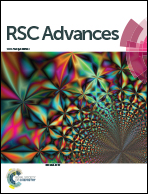One-step and template-free preparation of hierarchical porous carbons with high capacitive performance†
Abstract
Considering the wide application of hierarchical porous carbon materials (HPCs), one-step and template-free preparation of HPCs is very attractive. In this work, HPCs are prepared by direct carbonization of phenolic resin carboxylic salt xerogels. The morphology and porosity of the prepared carbon materials are characterized by scanning electron microscopy, transmission electron microscopy and nitrogen adsorption/desorption. The obtained HPCs possesses typically hierarchical porosity combined interconnected mesopores and highly accessible micropores with short diffusion length. Due to its unique hierarchical pore texture, the prepared carbon materials shows superior capacitive performance with high specific capacitance, excellent rate capability, and good long-term cycle stability in both KOH and N(C2H5)4BF4/acetonitrile electrolyte. Remarkable energy densities of 29.1 and 6.1 W h kg−1 are delivered by HPC-9d in organic and KOH electrolyte, respectively. At a very high power density of 10 000 W kg−1, the energy densities of HPC-9d still reach up to 14.4 and 4.5 W h kg−1 in organic electrolyte and KOH electrolyte, respectively, suggesting the prepared HPCs possess both high energy density and high power density.


 Please wait while we load your content...
Please wait while we load your content...